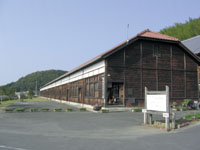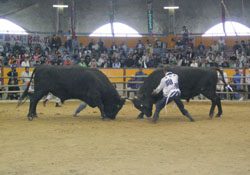In Search of Shikoku's Youth
Back to Contents of Issue: January 2004
|
|
|
|
by Dominic Al-Badri |
|
|
Welcome to Matsuyama, the prefectural capital of Ehime and the largest city on Shikoku, the smallest of Japan's four main islands. A city Matsuyama may be, but its atmosphere is definitely that of a country town, albeit one with a population of 450,000.
Until 1986, traveling to Shikoku from Honshu involved either flying or catching a ferry across the Inland Sea. (Ferries depart from Wakayama in Kansai all the way down to Beppu and beyond on the southernmost island of Kyushu.) Shikoku's 4 million inhabitants have a reputation for being a hardy, self-sufficient lot. Even by Japanese standards, the island is extremely mountainous, and until modern times most major centers remained relatively inaccessible.
Aware of the island's laggardly progress during the boom years of the 70s, several massive engineering projects were initiated to build a series of bridges to link Shikoku to Honshu. The first bridge, the Seto-Ohashi, was completed in 1988, while the final link, the Akashi Kaikyo Ohashi (the longest single-span suspension bridge in the world) was completed 10 years later. Total cost for all of the bridges: JPY3,400 billion.
Though undeniably impressive engineering feats, the benefits have not yet outweighed the costs. While the bridges were meant to encourage investment in Shikoku, it's more popularly said that the bridges have in fact simply made it easier to escape.
Sad and shabby
Uchiko, the more famous of the two, had its share of visitors, but Uwa was almost completely deserted. At high noon on a Saturday, I stood alone in the middle of the historical district. Uwa is one of the few stops for the limited express trains that hurtle through hourly from Matsuyama to my next major destination, Uwajima.
The Shikoku towns I visited located away from the tourist sights were generally sad, shabby affairs: run-down shopping arcades full of shops with rusty faades selling fashions long since bleached by the sun. This is the Japan that has been hollowed out and rarely gets written about. Not so much "lost Japan" as "forgotten Japan."
While the northern coast of Shikoku has some industrial development due to its proximity to Honshu, things become more rustic farther inland and south. In order to stimulate the economy during the 90s, all four of the island's prefectural governments placed their faith in tourism, and not just the ever-popular religious tourism (see J@pan Inc, September 2003), as the answer for their economic woes.
The prefectural governments are aware of the hollowing out that is taking place, and the money that is being poured in is being invested directly in tourism-related projects (like the upgrading of the various cultural institutions in Uwa) instead of ending up in the more typical road-to-nowhere pork-barrelism.
JR Shikoku currently offers a bewildering array of special tickets and access-all-area rail passes -- more than the rest of the nation's JR groups put together -- all in an effort to attract visitors. The measure of the desperation can be seen by one business plan targeting Kansai residents: Visit Matsuyama by train and get a night in one of the city's best hotels for free.
"Things haven't been good for these past four or five years," he told me. "Before that this place was more lively."
All day, the same question had been running through my mind: "Where are the youth?" They hadn't been hanging out in town on a Saturday, and I didn't expect to find them at the bullfights. Aaron Miller, an English teacher at a local high school, confirmed my suspicions. "There's nothing happening here. It's a nice enough place to live, especially if you like hot springs and the countryside, but all the young people have pretty much left."
The region's once thriving pearl industry has been badly affected. Those who might otherwise have been pearling packed up and left via the shiny bridges, heading to Honshu in search of work. The after-effects are lingering long and hard: Saturday night and we were the only people drinking in the entire Texas bar.
On Sunday morning I headed up to the Uwajima bull ring overlooking the city center. The bull ring was by no means sold out, though there was enough of a crowd to make for a convivial atmosphere.
The vast majority of the audience were locals -- wizened, weather-beaten and way past sixty, there for the sport and the local tradition. The younger element of the crowd was from out of town: a busload from Hiroshima, middle-aged couples from Okayama and a smattering of foreigners on the far side of the stadium. We watched the bulls headbutt each other for two and a half hours.
A samurai's sword
One of Japan's most enduring popular heroes is Ryoma Sakamoto. A Kochi native, Sakamoto was an archetypal "live fast, die young" rebel who was assasinated in Kyoto at the age of 33, having tried to drum up support for nationwide political upheaval.
Sakamoto's stoic refusal to tone down his pro-imperial rhetoric and calls for systemic change finally forced the ruling shogunate to cede to his calls. This eventually led to the Meiji Restoration in 1868, though Sakamoto was killed just a year earlier, cut down by a samurai's sword.
"Because Sakamoto died so young, he remains a popular figure even now with Japan's youth," explained Katsumi Ogura, director of the architecturally stunning Ryoma Sakamoto Memorial Museum in the seaside town of Katsurahama, just south of Kochi. "Of the approximately 120,000 visitors we have each year, about 60 percent are in their 20s or 30s. Sakamoto's a figure they can really admire, someone who managed to effect great change while still young. Perhaps some of the visitors will be inspired by his actions."
For now, while their elders tour the temples, the nation's youth head to Kochi, seeking inspiration at the feet of a restless idealist whose foresight helped shape modern Japan. @
|
|
Note: The function "email this page" is currently not supported for this page.


 "HEY, GAIJIN-SAN, WHAT are you doing here in Matsuyama?" asked a high school girl seated beside me in a humble ramen shop. She wasn't being obnoxious. Her tone was friendly, curious. I explained that I was researching a book, an answer she accepted, though she wasn't impressed. "Well, I can't wait to get out of here. It's so boring."
"HEY, GAIJIN-SAN, WHAT are you doing here in Matsuyama?" asked a high school girl seated beside me in a humble ramen shop. She wasn't being obnoxious. Her tone was friendly, curious. I explained that I was researching a book, an answer she accepted, though she wasn't impressed. "Well, I can't wait to get out of here. It's so boring."
 Fight night
Fight night



